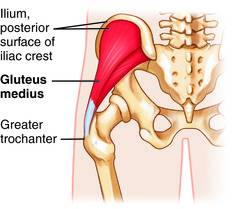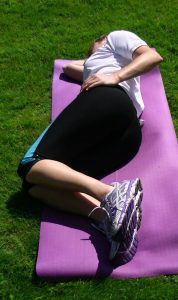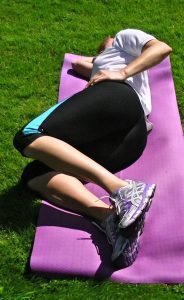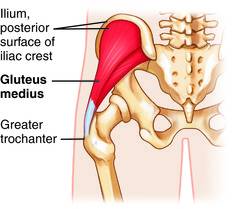Such exercises are imperative to help prevent back pain and as rehabilitation from any back injury. However, there is another important lower back pain exercise that is not often talked about. The muscle in question is Glute Med which helps to improve stability for the lower back (I think it sounds like the name of a Roman soldier!). It’s a buttock muscle so what does that have to do with back pain?
In order for the body to be balanced and strong in any movement each muscle needs to be doing its own job well. If one muscle isn’t working properly, another one has to try and cover for it. So if the muscles that help stabilise the pelvis aren’t working properly, it puts extra strain on the muscles of the back to try an counteract the effects of exercising on a wobbly pelvis when you are walking; running; lifting etc .
Whilst you may be able to do this for a short period, over time the compensations will result in dysfunction and injury. When the pelvis is unstable it can result in injuries of the hip, knee, ankle and foot, or the back.
So what does Glute Medius have to do with it?

When it works to move the leg it primarily acts as an abductor, meaning is takes your leg out sideways away from your body. The position of its muscle fibres means it also helps to rotate the thigh both inwards and outwards.
When your foot is planted on the floor or a solid surface, this muscle has a major role in stabilising the pelvis. For example, as you walk and your left foot is in contact with the ground, the glute medius muscle on the left should stabilise the pelvis so it doesn’t tilt excessively under the impact of the foot making contact with the ground.
If this muscle isn’t working properly it can cause problems to the back and all the way down the leg. It will allow the pelvis to tilt too much causing your hip drop on the opposite side as you walk. This will create excessive movement in your lower back, knee and foot, which will lead to weakness and possible injury over time.
Due to the long periods of time we end up sitting; at work, travelling, eating meals and relaxing at the end of a long day; this muscles gets elongated and becomes weaker in a lot of people.
Additionally, if you have ever had back pain, this muscle (amongst others) is likely to have been effected as the nerves supplying and communicating to it come from the lower back. If these get damaged or irritated it will impact on how well the body sends and receives messages to Glute Medius. As a result a little work is needs to strengthen this communication channel again.
All is not lost though. There is a simple lower back pain exercise you can do to help strengthen your Glute Medius again.
By doing the exercise below you will become more aware of this muscle, help your brain reconnect with it again and strengthen it to improve its functioning during your everyday tasks.
Strengthen Glute Medius with the Clam:
This may seem like an easy exercise, but it’s important that you take time to be sure you are doing it properly.
As with a lot of stabilising muscle exercises, the goal here is not how much you can lift or how many reps you can force yourself to do. The aim is to do perfect repetitions each time, at a slow and controlled pace. If you can only achieve 2 perfect repetitions before the muscle weakens then that’s the time to stop.
By forcing yourself to do more you are only strengthening the poor muscle activation patterns that you are trying to change. Once you feel you are not able to do the exercise perfectly any more, stop for the day. Next time you may be able to do one more.
How to do the Clam:
- Lie on your side on firm surface so you know you will be correctly aligned. Use a mat, carpeted floor, rug or towel for comfort.
- Bend your knees to about 30 degrees so that your shoulders, hips and ankles are in line with each other.
- Have your feet one on top of the other and your lower hand under your head.

- With the other hand, place your heel of that hand on the pelvic bone and push it slightly forwards – this help prevent you form rocking the pelvis back as you perform the movement.
- Focus your attention on your buttocks and squeeze your glutes to lift the top knee up and away from the bottom knee.
- ENSURE YOUR FEET STAY IN CONTACT WITH EACH OTHER AND YOUR PELVIS STAYS PERFECTLY STILL.

- You should feel the tension in your bottom as you lift the knee. Don’t expect it to lift a much, this will not be a big movement. If you find you can lift the knee quite high, check you are not rocking or twisting your pelvis backwards as you lift your knee.
As I mentioned before, only repeat this for as many times as you can do it perfectly.
The goal is to get to 3 lots of 10 repetitions. After each bout of 10, change sides to work on the opposite muscle and give the other a rest. It may be you can only do 3 on each side to begin with, that’s perfectly fine. You will notice over time that you are able to do more.
I hope this lower back pain exercise gives a little more support to your back along side the other great things you are doing.

